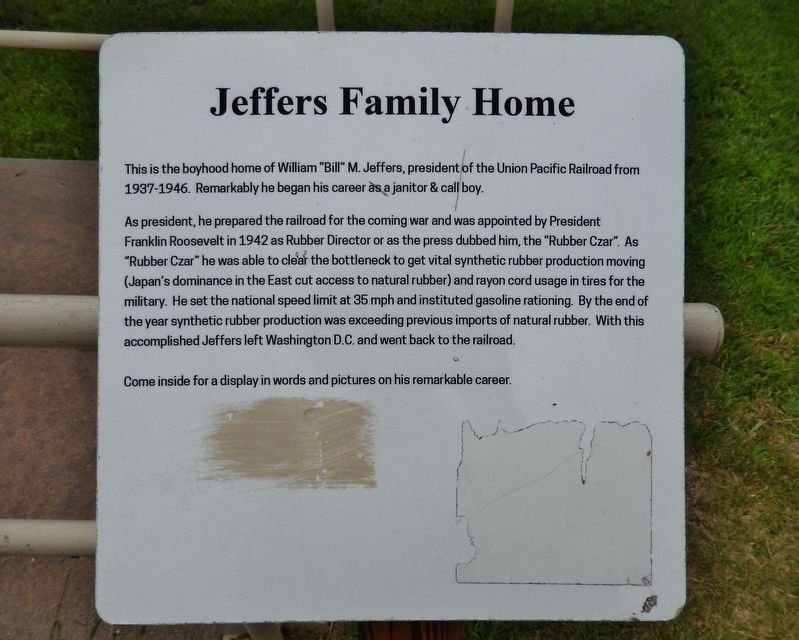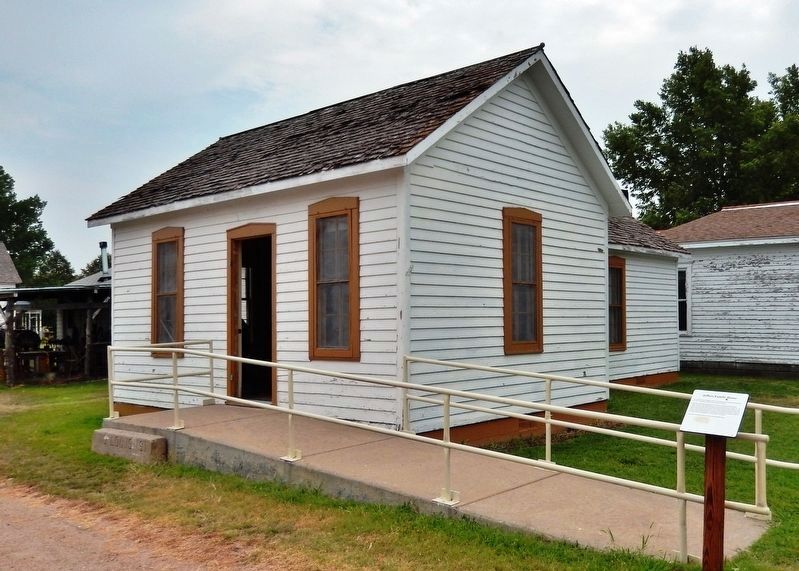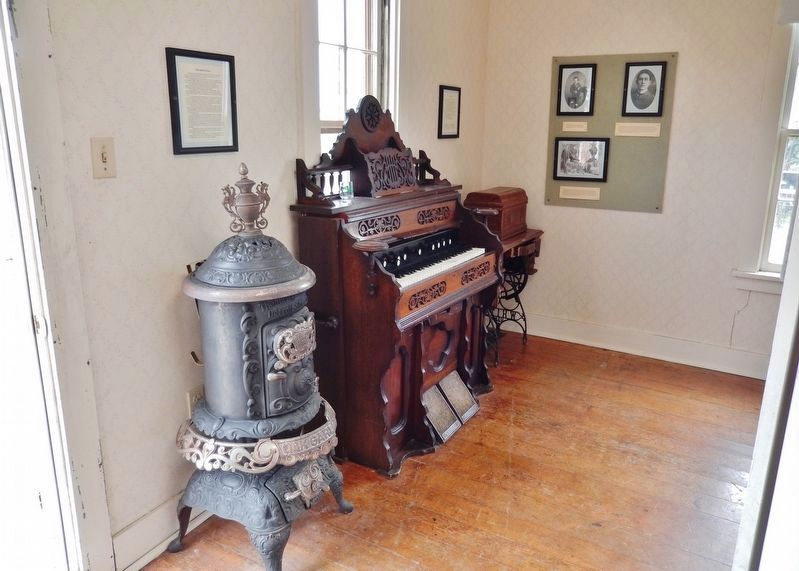Jeffers Family Home
As president, he prepared the railroad for the coming war and was appointed by President Franklin Roosevelt in 1942 as Rubber Director or as the press dubbed him, the "Rubber Czar". As "Rubber Czar" he was able to clear the bottleneck to get vital synthetic rubber production moving (Japan's dominance in the East cut access to natural rubber) and rayon cord usage in tires for the military. He set the national speed limit at 35 mph and instituted gasoline rationing. By the end of the year synthetic rubber production was exceeding previous imports of natural rubber. With this accomplished Jeffers left Washington D.C. and went back to the railroad.
Come inside for a display in words and pictures on his remarkable career.
Topics and series. This historical marker is listed in these topic lists: Industry & Commerce • Railroads & Streetcars • War, World II. In addition, it is included in the Former U.S. Presidents: #32 Franklin D. Roosevelt series list. A significant historical year for this entry is 1942.
Location. 41° 9.635′ N, 100° 47.394′ W. Marker is in North Platte, Nebraska, in Lincoln County. Marker can be reached from North Buffalo Bill Avenue, 0.8 miles north of Lincoln Highway (U.S. 30), on the right when traveling north. Marker and Jeffers Home are located on the Lincoln County Historical Museum grounds. Touch for map. Marker is at or near this postal address: 2403 North Buffalo Bill Avenue, North Platte NE 69101, United States of America. Touch for directions.
Other nearby markers. At least 8 other markers are within walking distance of this marker. U. P. Caboose #25486 (a few steps from this marker); Pawnee Indian Garden (a few steps from this marker); Blacksmith Shop (a few steps from this marker); General Store (a few steps from this marker); Union Pacific Depot (within shouting distance of this marker); Ericsson House (within shouting distance of this marker); Brady Island Depot (within shouting distance of this marker); Ox Yokes (within shouting distance of this marker). Touch for a list and map of all markers in North Platte.
Related markers. Click here for a list of markers that are related to this marker. Lincoln County Historical Museum
Also see . . . UP President and America’s “Rubber Czar”.
Bill Jeffers lived and breathed the railroad. Born into a North Platte railroad family in 1876, he caught on as a UP call boy at age 14. He worked his way up the ladder, from dispatcher to yardmaster to general manager, eventually becoming president in 1937. In 1942, President Roosevelt tapped Jeffers to serve as the nation’s “rubber czar” during the early days of the war when Japan cut off imports from the East Indies. “Battling Bill” Jeffers brought a midwestern, blue collar, “get it done” attitude to Washington that ruffled bureaucratic feathers. The man who said proudly, “I’d rather be President of the Union Pacific than President of the United States,” died in 1953.(Submitted on February 11, 2022, by Cosmos Mariner of Cape Canaveral, Florida.)
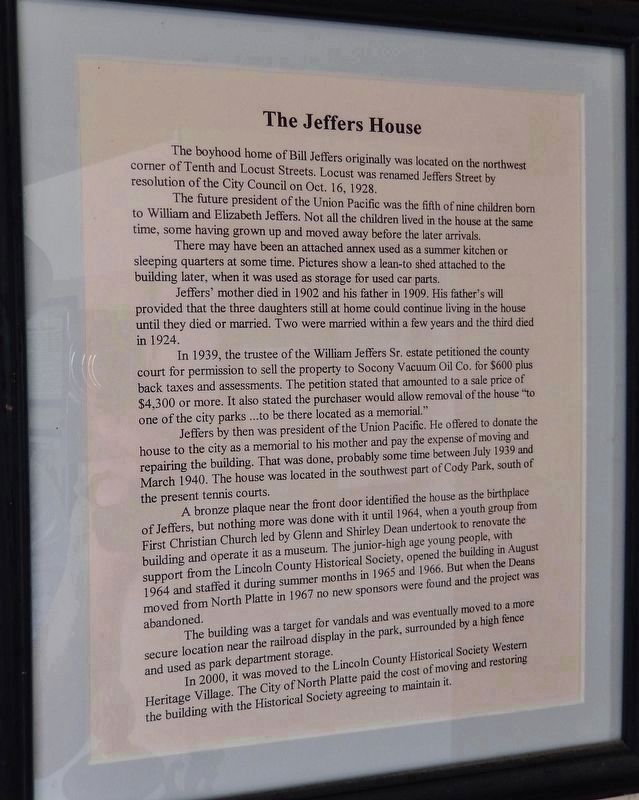
The future president of the Union Pacific was the fifth of nine children born to William and Elizabeth Jeffers. Not all the children lived in the house at the same time, some having grown up and moved away before the later arrivals.
There may have been an attached annex used as a summer kitchen or sleeping quarters at some time. Pictures show a lean-to shed attached to the building later, when it was used as storage for used car parts.
Jeffers' mother died in 1902 and his father in 1909. His father's will provided that the three daughters still at home could continue living in the house until they died or married. Two were married within a few years and the third died in 1924.
In 1939, the trustee of the William Jeffers Sr. estate petitioned the county court for permission to sell the property to Socony Vacuum Oil Co. for $600 plus back taxes and assessments. The petition stated that amounted to a sale price of $4,300 or more. It also stated the purchaser would allow removal of the house "to one of the city parks …to be there located as a memorial."
Jeffers by then was president of the Union Pacific. He offered to donate the house to the city as a memorial to his mother and pay the expense of moving and repairing the building. That was done, probably sometime between July 1939 and March 1940. The house was located in the southwest part of Cody Park, south of the present tennis courts.
A bronze plaque near the front door identified the house as the birthplace of Jeffers, but nothing more was done with it until 1964, when a youth group from First Christian Church led by Glenn and Shirley Dean undertook to renovate the building and operate it as a museum. The junior-high age young people, with support from the Lincoln County Historical Society, opened the building in August 1964 and staffed it during summer months in 1965 and 1966. But when the Deans moved from North Platte in 1967 no new sponsors were found, and the project was abandoned.
The building was a target for vandals and was eventually moved to a more secure location near the railroad display in the park, surrounded by a high fence and used as park department storage.
In 2000, it was moved to the Lincoln County Historical Society Western Heritage Village. The City of North Platte paid the cost of moving and restoring the building with the Historical Society agreeing to maintain it.
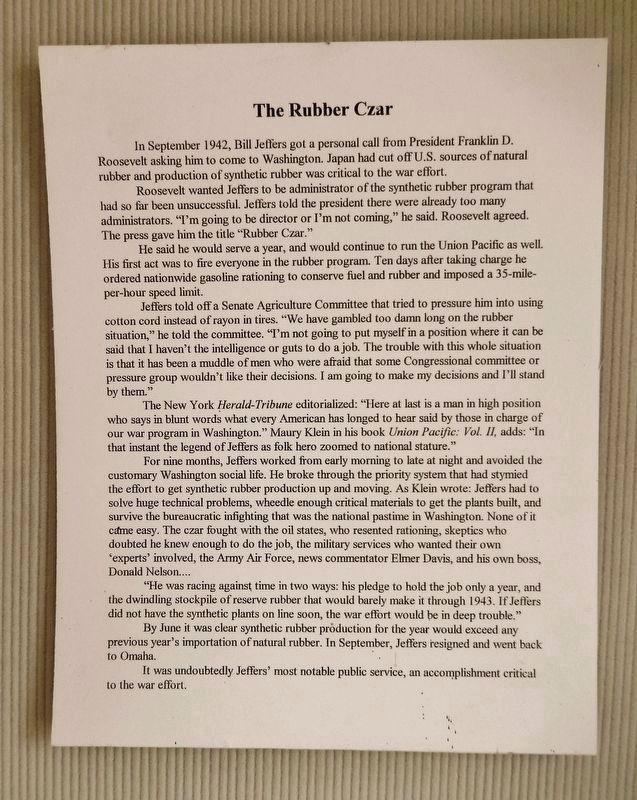
Roosevelt wanted Jeffers to be administrator of the synthetic rubber program that had so far been unsuccessful. Jeffers told the president there were already too many administrators. "I'm going to be director or I'm not coming," he said. Roosevelt agreed. The press gave him the title "Rubber Czar."
He said he would serve a year, and would continue to run the Union Pacific as well. His first act was to fire everyone in the rubber program. Ten days after taking charge he ordered nationwide gasoline rationing to conserve fuel and rubber and imposed a 35-mile-per-hour speed limit.
Jeffers told off a Senate Agriculture Committee that tried to pressure him into using cotton cord instead of rayon in tires. "We have gambled too damn long on the rubber situation," he told the committee. "I'm not going to put myself in a position where it can be said that I haven't the intelligence or guts to do a job. The trouble with this whole situation is that it has been a muddle of men who were afraid that some Congressional committee or pressure group wouldn't like their decisions. I am going to make my decisions and I'll stand by them."
The New York Herald-Tribune editorialized: "Here at last is a man in high position who says in blunt words what every American has longed to hear said by those in charge of our war program in Washington." Maury Klein in his book Union Pacific: Vol. II, adds: "In that instant the legend of Jeffers as folk hero zoomed to national stature."
For nine months, Jeffers worked from early morning to late at night and avoided the customary Washington social life. He broke through the priority system that had stymied the effort to get synthetic rubber production up and moving. As Klein wrote: Jeffers had to solve huge technical problems, wheedle enough critical materials to get the plants built, and survive the bureaucratic infighting that was the national pastime in Washington. None of it came easy. The czar fought with the oil states, who resented rationing, skeptics who doubted he knew enough to do the job, the military services who wanted their own 'experts' involved, the Army Air Force, news commentator Elmer Davis, and his own boss, Donald Nelson....
"He was racing against time in two ways: his pledge to hold the job only a year, and the dwindling stockpile of reserve rubber that would barely make it through 1943. If Jeffers did not have the synthetic plants on line soon, the war effort would be in deep trouble."
By June it was clear synthetic rubber production for the year would exceed any previous year's importation of natural rubber. In September, Jeffers resigned and went back to Omaha.
It was undoubtedly Jeffers' most notable public service, an accomplishment critical to the war effort.
Credits. This page was last revised on March 3, 2024. It was originally submitted on February 11, 2022, by Cosmos Mariner of Cape Canaveral, Florida. This page has been viewed 197 times since then and 39 times this year. Photos: 1, 2, 3, 4, 5. submitted on February 11, 2022, by Cosmos Mariner of Cape Canaveral, Florida.
